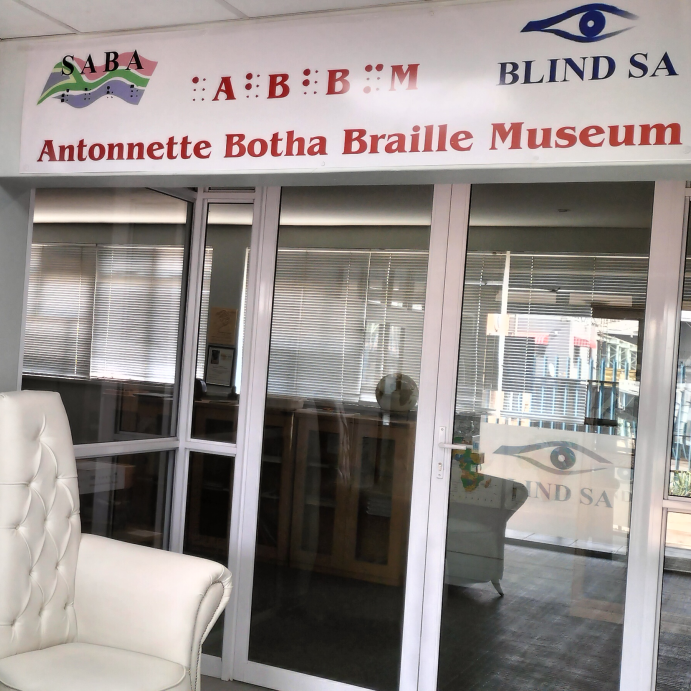
Braille Services
⠃⠗⠁⠊⠇⠇⠑ ⠎⠑⠗⠧⠊⠉⠑⠎

Braille Services History in SA
1952- 1953
Foundation of the Braille Transcription Bureau (1952-1953)
During the SABWO (South African Blind Workers Organisation) Head Committee of 17-19 December 1952, a decision was taken to request the establishment of a braille transcription service for the blind by the SA National Council for the Blind.
After much deliberation, the Braille Transcription Bureau was established by SABWO on 1 August 1953. The Terms of Reference for the Bureau, as approved by SABWO Central Management (on 1958)
“to provide in the need for braille irrespective of the individual, religious belief, race or institution.” – SABWO
1953-1963
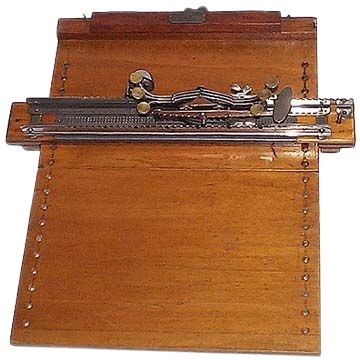
Early Years and Manual Production
Mr Ernst Kruger was appointed as the Director, while his wife Monica was the first voluntary braille typist. In its first ten years, braille was produced manually on a Stainsby brailler, a small portable braille typewriter.
Because no means of duplication existed at the time, the emphasis was on the production of single copies mainly for personal use. The first complete work produced was for Mr JC Harmse, “Constitution of the National Party of Transvaal” in Afrikaans, a copy of which is proudly displayed in this museum.
1960’s
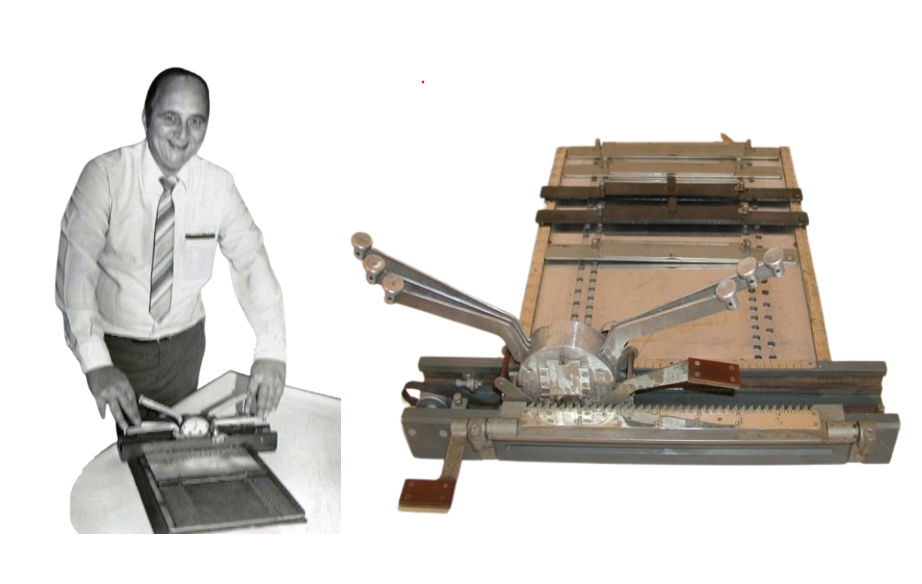
Expansion and Provision of Multiple Copies
To make provision for multiple copies, a “Crabb” braille machine was imported from England. The Crabb brailler was developed by RNIB in England and used by Braille Services to produce braille plate masters.
With it, braille was written on a light gauge double metal sheet, from which a limited number of paper braille duplicates could be made, using a washing machine mangle. The process was slow, laborious and costly.
1963

Formalization and Renaming
SABWO’s first full-time employee, Mrs Elize Venter, started on 2 February 1960 as an administrative officer and on 15 January 1962 Angelique Wessels (née van der Spuy; visually impaired) became the first braille transcriber and proofreader.
Mr Antonie Zeelie, a braille transcriber from the School for the Blind in Worcester, joined the team on 1 July 1963 as Head Printer. Shortly afterwards, a messenger, Mr Reuben Radise, was appointed and he later became the Head-of-Department: Printing Press.
On 22 August 1963 a joint management committee was established between SABWO and SANCB (South African National Council for the Blind) and the Braille Transcription Bureau was renamed as Braille Services, with Dr Walter Cohen as first chairperson (1963-1980) and Mr Ernst Kruger as Director (1963-1996).
In the picture above Mr Antonie Zeelie can be seen using an English-manufactured BEM No. 7 (Braille Embossing Machine). It was similar to the machines used by Pioneer Printers in Worcester at the time. Duplication was done on a French-manufactured Jurine platen, still in use today! These machines were imported by Evelyn Haddon from France in July 1964 at a cost R4 000.
1964

Technological Advancements
In 1964 two power driven machines, the German “Marburger” and British “Stereotyper”, with which braille was written on heavy gauge aluminium sheets. This process was much faster and a virtually unlimited number of copiers could be produced on an electric-powered “Jurine” platen press.
Above Mr Mandla Ralph Mncube, our first African braille transcriber, is seen brailling a book on the German-manufactured “Marburg Braille Stereotyper” (Photo: 1968)
1972-1978
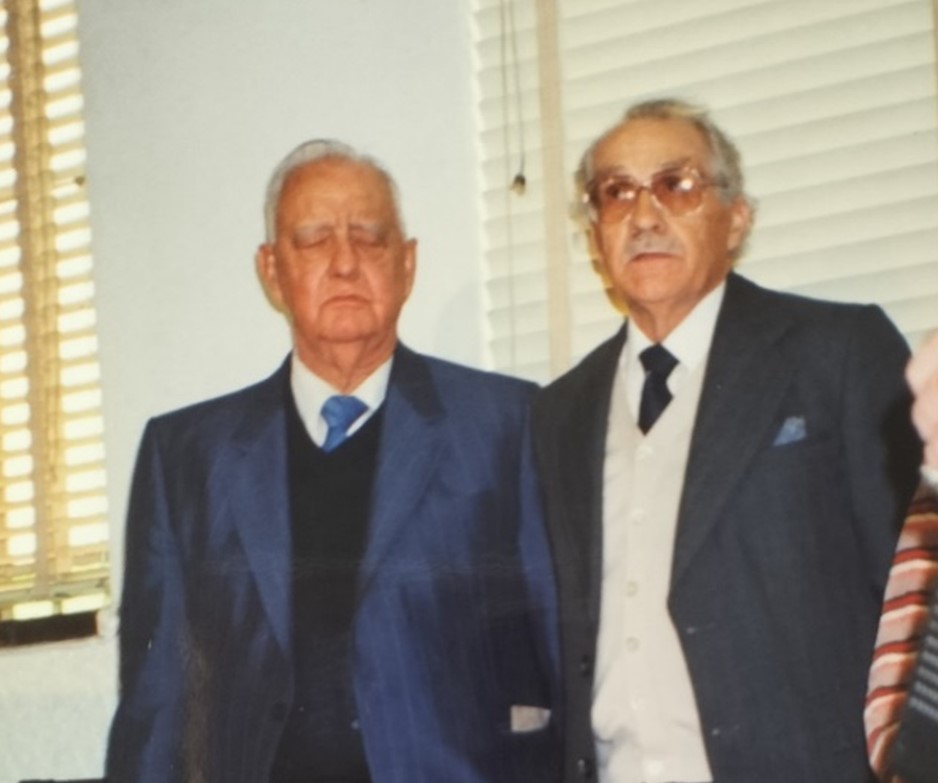
Expansion into African Languages
The first African-language Bible book produced in braille was Luke in North Sotho, handed to Ds Loots from The Bible Society in SA on 24 June 1972.
On 12 August 1993, Mark in Venda braille was handed to Ds Steff Boshoff, Head Secretary of Bible Society in SA. During the hand-over, Mr Alson Tshisevhe (Venda-language braille proofreader), read a few verses from Mark 13 to the audience. A total of 25 copies were produced.
1979
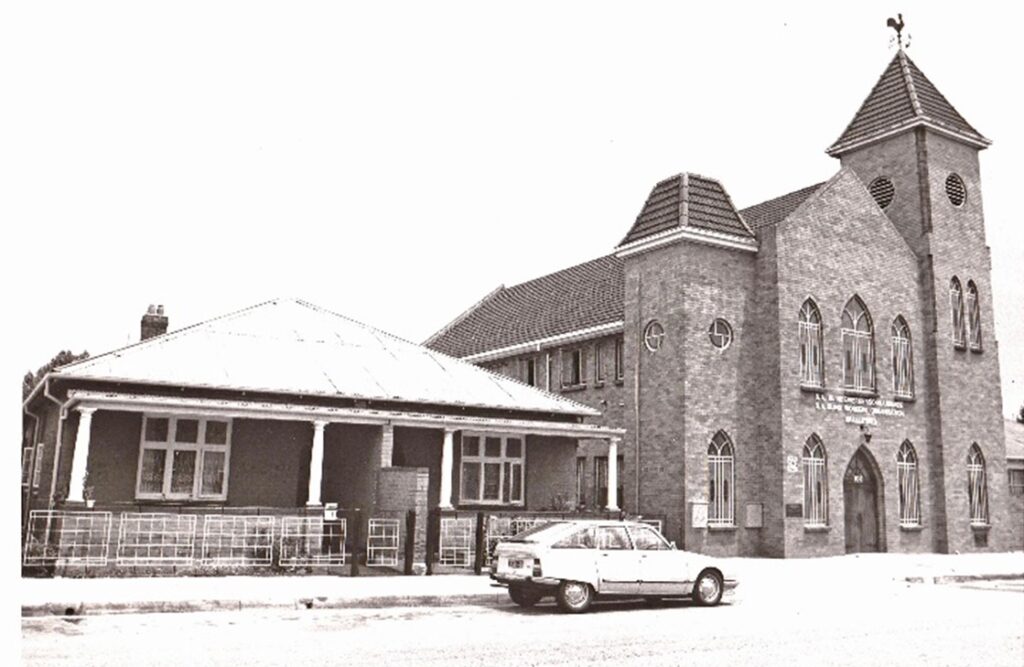
Expansion
The ever-increasing need for braille led to the acquisition of a church building in Mayfair, Johannesburg. It was officially opened on 12 January 1979.

Ms Monica and Mr Ernst Kruger during the opening of the SABWO Head Office and Braille Services building in Mayfair on 12 January 1979. They are holding a portrait of Louis Braille, a gift from the SA National Council for the Blind.

Photo taken during the opening of the Braille Services building on 12 January 1979: (from left to right) Mayor of Johannesburg Clr. Dr. Otto, Ms Cruywagen, Minister Cruywagen, Mr Ernst Kruger, Mr Zeelie and Mr Mncube, the braille transcriber.
1980
During the 1980s the demand for braille rose to the extent that manual production was no longer practicable. With the aid of USA technology, Braille Services become the first printing house in South Africa to switch to computerised braille production.
Collaboration between Prof. Solms, Department of Computer Sciences at Rand Afrikaans University (now University of Johannesburg), Ms Lettie van Tonder, computer scientist at UNISA, and Mr Joseph Sullivan of Duxbury Systems in the USA, the first automated Afrikaans braille translations were successfully completed on 1 February 1981.
Soon conversion tables for our African languages followed, and today Braille Services produce braille in all our official languages.
2008-2012
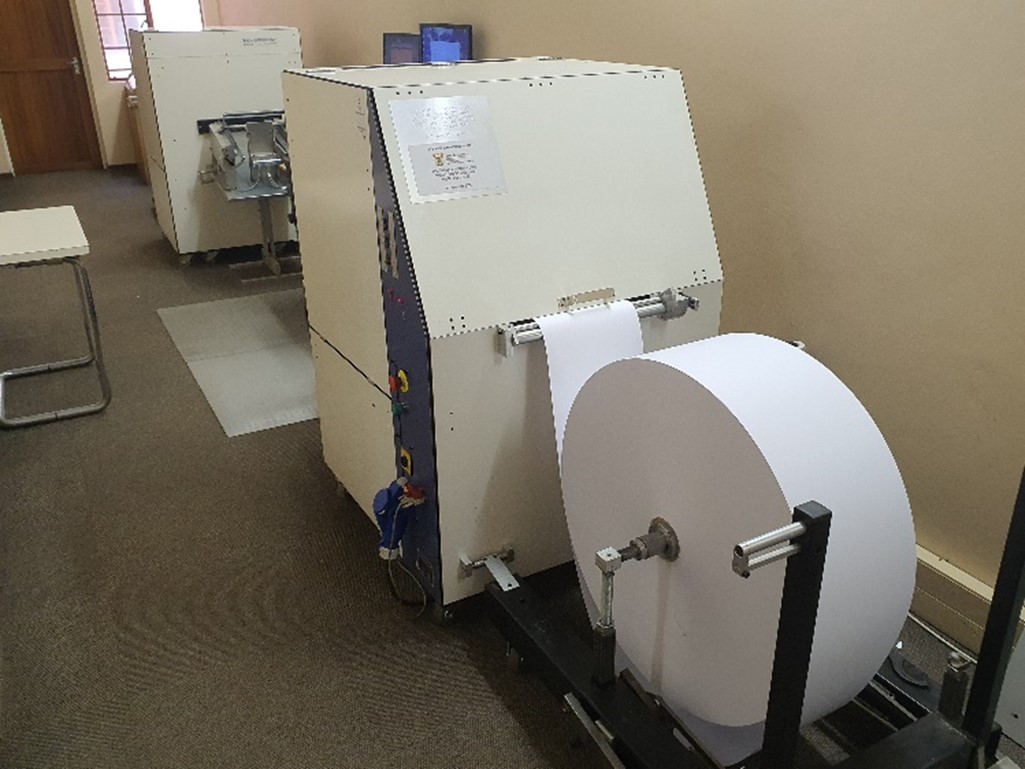
Modernization
The first electronic braille embossers used were the USA-manufactured Enabling Technology Company’s TED400 and Express150 machines, but in 2008 and again in 2012 we acquired the world’s fastest braille embossers, the Belgium-manufactured Interpoint55. Printing directly onto a paper reel, it can finish more than a thousand braille pages per hour!
2005
Diversification
Another field of expertise is the production of tactile graphics – in the past we produced hand-drawn or photostat swell-paper copies, but in 2005 we moved to computer-generated graphic designs with Corel Draw and Tiger Pro graphic embossers.
1996-2019
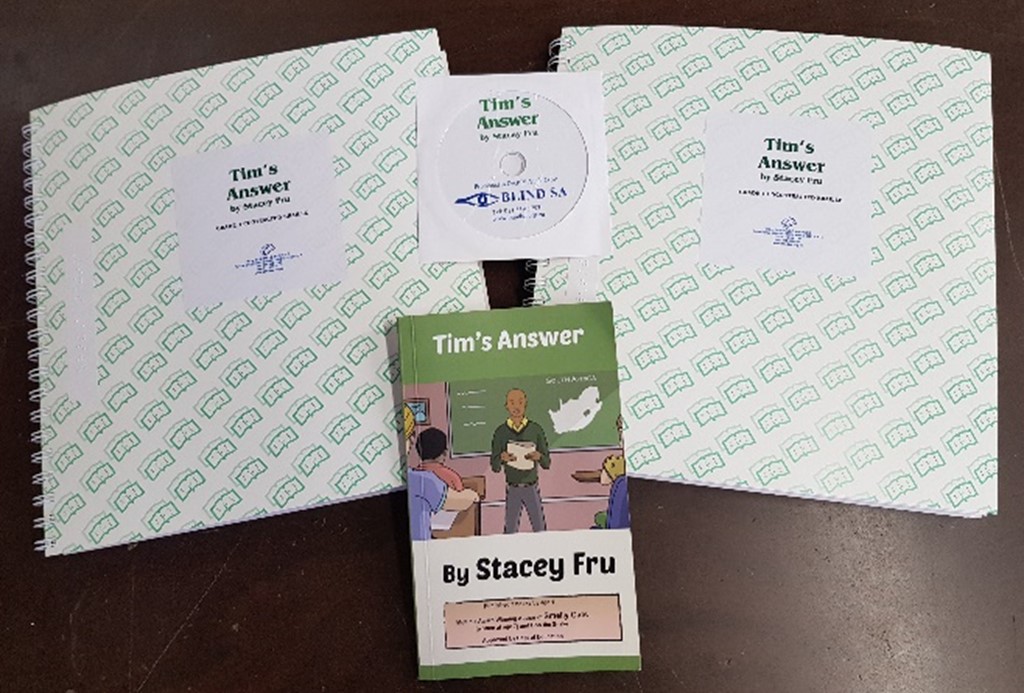
Contributions and Achievements
Over the years Braille Services were responsible for a number of “firsts”: we produced the braille edition of the “Constitution of South Africa”
In 1996, braille labels for lifts, braille business cards, the Government Communications & Information Systems’ Vuk’uzenzele magazine, information plaques for various botanical gardens all over South Africa, and in 2019 we assisted child-author Stacey Fru with the braille and DAISY-editions of her book “Tim’s answer” during the simultaneous launch of the print version as seen in the image above.
1997-2019
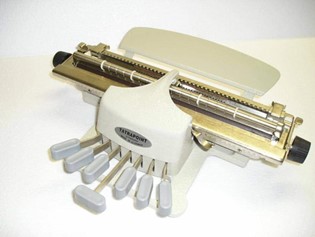
Maintenance Services
Another field of expertise is the repair and service of mechanical braille writing machines – our first Perkins brailler technicians were trained in 1997, and in 2019 another two technicians were trained to service and repair the TatraPoint brailler. To date, far in excess of 2 000 machines were serviced and repaired!
2016-2017
Expansion into Daisy Format
In 2016 Braille Services expanded its scope of operation even further and acquired the skills to produce material in Daisy format. Apart from producing our magazines in this format, the first book to be produced in Daisy was Cry the Beloved Country by Alan Paton in early 2017. The establishment of the Blind SA Bookshare library provides the facility of making available material produced by Braille Services in Epub and braille formats.

“If we have no braille, we lose culture, we lose life, we lose everything”
Dr Walter Cohen, SABWO founding member and Braille Transcription Buro chairman 1963-1980



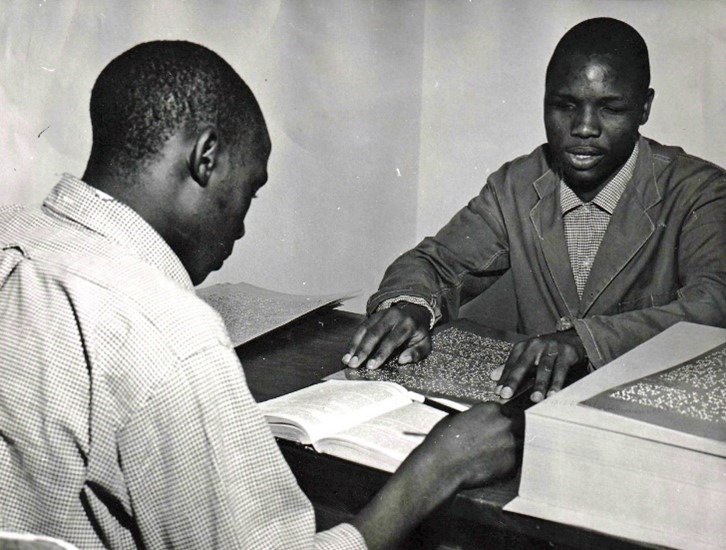



A Short View into Pioneer Printers’ History
Pioneer Printer’s Braille Products: Accessible Solutions
Expert Transcription:
Our experienced team ensures top-quality braille transcription by meticulously editing content and layout to meet braille standards. We provide tactile graphics for subjects like Music, Math, and Science.
What We Offer
- Educational Subjects
- Annual Reports (Braille and audio)
- Menus
- School Textbooks
- Braille Information Plates
- Business Cards (Text and braille)
The History
1881
Establishment
• A decision taken by the Western Cape Synod of the SA Dutch Reformed Church in 1880 led to the establishment of the “Het Doofstommen en Blinden Instituut” in Worcester.
• The School for the Blind was established in 1881 to attend to the needs of a blind child that was admitted on 15 June 1881.
1903
The 1st Braille Press
The School for the Blind purchased the first braille press.
1904
The 1st Braille Newsletter
The first newsletter of the school, called “De Pionier”, was printed in braille.
1930
Printing
Braille was printed at the school’s printing unit called Môreligpers.
1940
Afrikaans
The first Afrikaans braille Bible was printed.
1943
Music
The first braille music notation was printed.
1959
The 1st Audio Book
The first audio book was recorded.
1964
Large letter print was initiated.
1980
Move to Worcester
The braille, audio and large print literature production units moved into the Victor Vaughan building in Langerug, Worcester. The building premises is owned by the Dutch Reformed Church (DRC) and managed by the Institute for the Blind, now called Innovation for the Blind.
1995
Pioneer Printers
The literature production unit of the school became known as Pioneer Printers.
1996
Public School
Previously the Institute for the Blind and Pioneer School, including Pioneer Printers, were governed by a board of control. With the introduction of the new SA Schools Act of 1996, Pioneer School became a public school under the Western Cape Education Department, with its own School Governing Body, which also included Pioneer Printers.
2007
The 1st for digital
The first tactile graphics were developed in digital format and embossed on a specialised electronic tactile graphic embosser.
The first digital audio recordings were made in MP3 format and duplicated onto CD
2012
Digital development of large print in specific Arial font 18 on A4 size paper was introduced.
2016
We became an NPO
Pioneer Printers started to operate independently as a non-profit organisation with its own constitution and governing board.
An African languages braille production team was established.
2017
Pioneer Printers started a restructuring process and merged the Braille, Braille Music and Large Print transcribing functions into one section, the Tactile Graphics and Large Print Graphics functions into one section, and the Braille Proofreading and Large Print Proofreading functions into one section – each with a Component Head.
2018
Department of Basic Education included audio format NSC examination papers in their purchase order to Pioneer Printers.
Pioneer Printers took the full financial responsibility of braille music production for the SA Braille Music Library at Pioneer School.
2019
The management information system and high-volume braille embossing equipment were upgraded, replacing the obsolete BraillePlace and Express embossers with our first Braillo600 and BrailleBox printers.
SA Braille Authority awarded certificates of accreditation to braille producers and Pioneer Printers was certified as a specialised braille producer of the technical braille categories in accordance with the standards based on international UEB/UBC requirements.
2020
• Just before Covid-19 national lockdown Pioneer Printers delivered all the braille CAPS textbooks to DBE (developed since 2013) and DBE took responsibility of the braille master development costs.
• Our high-volume braille and tactile graphic embossing equipment were upgraded replacing the obsolete Tiger Viewplus embossers with another Braillo600 and Elite tactile graphic embossers.
• Innovation for the Blind gave Pioneer Printers permission to install a 50kWh rooftop photovoltaic solar system and upgrade the front entrance of the Victor Vaughan building.
2021
• Pioneer Printers was requested by Innovation for the Blind and Bible Society of SA to transcribe the 2020 translation of the Afrikaans Bible in braille.
• “Die Pionier”, the oldest Afrikaans braille magazine in SA, is published for the 85th year.
• A 3D-printer was purchased to expand our services in the tactile function.
Blind SA Braille Services
Blind SA established its Braille Services in 1953 and remains the only producer of braille documents in all eleven official languages of South Africa.
Our Braille Services supplies customers with material at about 25% of the actual production cost. The additional costs are funded by the generosity of Blind SA’s donors.
We produce braille to order only, and try to meet the reading needs of all our customers. Each page of every textbook needs to be transcribed into a braille master page, then duplicated and bound into useful study aids.
Our Heidelberg GT Platen Press allows for quick production and with our Viewplus Braille and state-of-the-art software, means we can print tactile diagrams and pictures.
SA Library for the Blind
SALB’s braille production services aim to provide visually impaired individuals with access to a comprehensive range of reading materials in braille, thereby promoting literacy, education, and inclusion within the visually impaired community in South Africa.
Braille Production:
- SALB produces high-quality braille materials in the eleven official languages of South Africa.
- Trains staff in mastering braille skills and utilizing specialized technologies for braille production.
SA Library for the Blind
History
The Library serves a specific constituency and therefore it is socially committed to strive, by its own efforts and in co-operation with others, for the removal, as far as possible, of barriers to accessing information.
It is committed to providing a quality service that fully meets the information needs of all South Africans who are blind or print handicapped.
The Library is an entity of the Department of Sport, Arts and Culture.
From Humble Beginnings
The South African Library for the Blind (SALB) was conceived and born of humble beginnings in the then tiny Eastern Cape township of Grahamstown during the height of the 1918 global Influenza pandemic.
While nursing local influenza victims, Josephine (Josie) Wood met Miss Comber, a British nurse who wished to establish religious study groups for the blind. Later, having been recalled to England, Miss Comber, who had developed a personal collection of 100 braille volumes, convinced Josie Wood to develop an accessible library for the visually impaired.
Her acceptance marked the beginning of the library for the visually impaired in South Africa – and led directly to the proudly South African institute today.
The Library has mini-libraries across South Africa and assists blind people with accessing information proudly, as they have these past 100 years.
Milestones
1919
Josie Wood establishes a small library in a little room in her house
1923
A Library Committee is appointed to give the Library official status
1930
The Library pays off the bond on the building a grant from the Carnegie Corporation of New York
1949
The Library receives the first talking book machines from overseas
1953
The S.A. Post office grants the Library and its members a free post concession
1968
The Library is declared a Cultural Institution and National Library for the Blind
1970
The National Union Catalogue for the Blind was started as a card catalogue
1985
The four track tape system comes into operation
1992
Audio and Braille in-house production units are established
2004
Production of Digital Audio books in Daisy format commenced
2008
Raised funds to purchase 2,831 Daisy players for free distribution to members; Tactile Book Production
2019
SALB celebrates 100 Years!
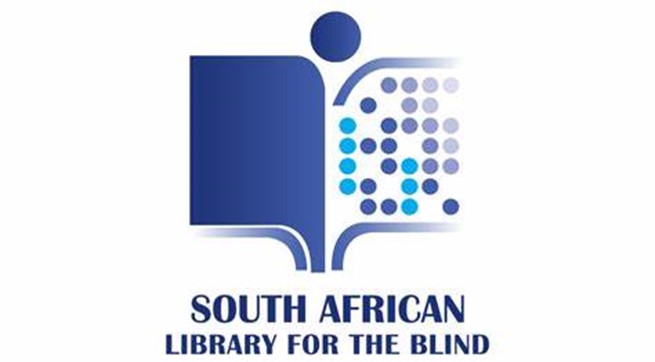

Braille Music
SANB |
SOUTH AFRICAN NATIONAL BRAIILE MUSIC LIBRARY
This service is FREE and consist of braille music for beginners through to the most advanced musicians. There are music pieces available for nearly any instrument, from the violin, guitar, recorder to the piano, organ and keyboard and many more. Braille music manuals are available for beginners.
Hester van Greunen is the librarian at the South African Braille Music Library in Porter Street, Worcester. This library is registered as a national library and is unique in the southern hemisphere and Africa!
Braille Music in South Africa
Braille music is a braille code that allows music to be notated using braille cells so music can be read by visually impaired musicians. The system was incepted by Louis Braille.
Braille music uses the same six-position braille cell as literary braille. However braille music assigns its own meanings and has its own syntax and abbreviations. Almost anything that can be written in print music notation can be written in braille music notation. However, the notation is an independent and well-developed system with its own conventions.
The world’s largest collection of the notation is at the Library of Congress in the United States.
In South Africa the first music notation was transcribed to braille in 1943.
The library in Worcester consist of braille music and is available to all blind musicians – teachers and learners throughout South Africa and Africa.
This service is free and consist of braille music for beginners through to the most advanced musicians. There is music pieces available for nearly any instrument, from the violin and guitar to the piano, organ, keyboard and many more.
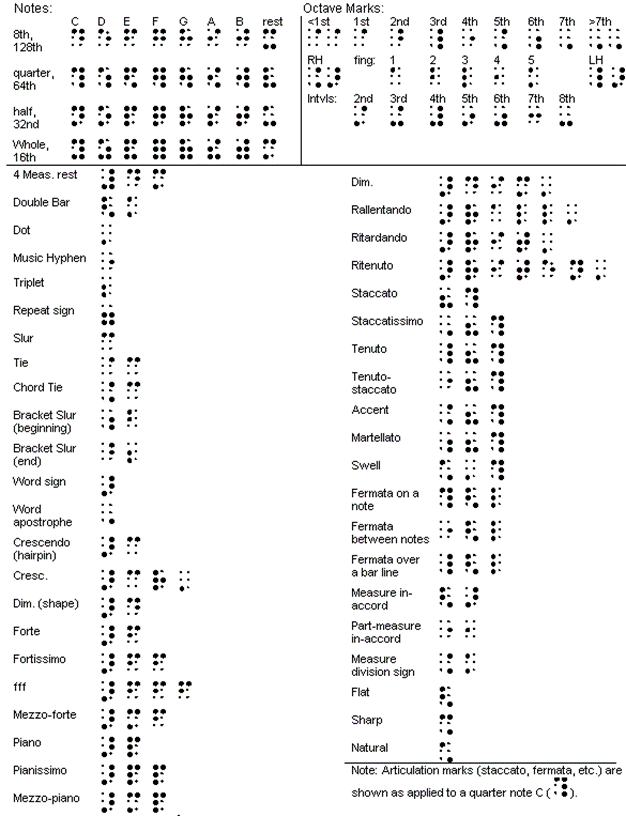


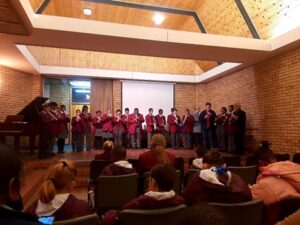

You can make a difference!
By donating to the museums cause you can make a difference in the preservation of Braille’s History.

